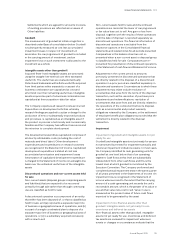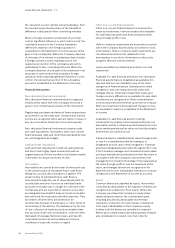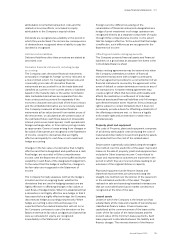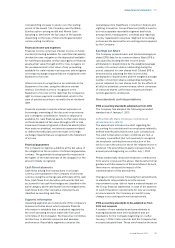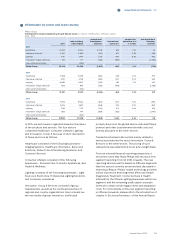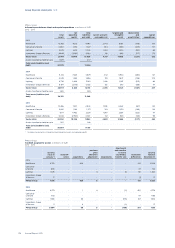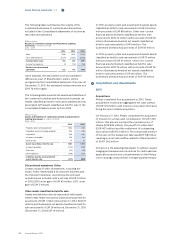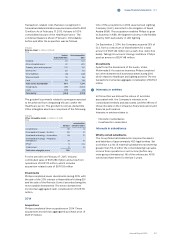Philips 2015 Annual Report Download - page 121
Download and view the complete annual report
Please find page 121 of the 2015 Philips annual report below. You can navigate through the pages in the report by either clicking on the pages listed below, or by using the keyword search tool below to find specific information within the annual report.Group nancial statements 12.9
Annual Report 2015 121
corresponding increase in equity, over the vesting
period of the award. The Company uses the Black-
Scholes option-pricing model and Monte Carlo
sampling to determine the fair value of the awards,
depending on the type of instruments granted and
certain vesting conditions.
Financial income and expenses
Financial income comprises interest income on funds
invested (including available-for-sale nancial assets),
dividend income, net gains on the disposal of available-
for-sale nancial assets, net fair value gains on nancial
assets at fair value through prot or loss, net gains on
the remeasurement to fair value of any preexisting
available-for-sale interest in an acquiree, and net gains
on foreign exchange impacts that are recognized in the
Statement of income.
Interest income is recognized on accrual basis in the
Statement of income, using the eective interest
method. Dividend income is recognized in the
Statement of income on the date that the Company’s
right to receive payment is established, which in the
case of quoted securities is normally the ex-dividend
date.
Financial expenses comprise interest expenses on
borrowings, unwinding of the discount on provisions
and contingent consideration, losses on disposal of
available-for-sale nancial assets, net fair value losses
on nancial assets at fair value through prot or loss,
impairment losses recognized on nancial assets (other
than trade receivables), net interest expenses related
to dened benet plans and net losses on foreign
exchange impacts that are recognized in the Statement
of income.
Financial guarantees
The Company recognizes a liability at the fair value of
the obligation at the inception of a nancial guarantee
contract. The guarantee is subsequently measured at
the higher of the best estimate of the obligation or the
amount initially recognized.
Cash ow statements
Cash ows arising from transactions in a foreign
currency are translated in the Company’s functional
currency using the exchange rate at the date of the cash
ow. Cash ows from derivative instruments that are
accounted for as cash ow hedges are classied in the
same category as the cash ows from the hedged items.
Cash ows from other derivative instruments are
classied as investing cash ow.
Segment information
Operating segments are components of the Company’s
business activities about which separate nancial
information is available that is evaluated regularly by
the chief operating decision maker (the Executive
Committee of the Company). The Executive Committee
decides how to allocate resources and assesses
performance. Reportable segments comprise the
operating sectors Healthcare, Consumer Lifestyle and
Lighting. Innovation, Group & Services (IG&S) is a sector
but not a separate reportable segment and holds,
among others, headquarters, overhead and regional/
country organization expenses. Segment accounting
policies are the same as the accounting policies applied
by the Company.
Earnings per Share
The Company presents basic and diluted earnings per
share (EPS) data for its common shares. Basic EPS is
calculated by dividing the Net income (loss)
attributable to shareholders by the weighted average
number of common shares outstanding during the
period, adjusted for own shares held. Diluted EPS is
determined by adjusting the Net income (loss)
attributable to shareholders and the weighted average
number of common shares outstanding during the
period, adjusted for own shares held, for the eects of
all dilutive potential common shares, which comprises
of restricted shares, performance shares and share
options granted to employees.
New standards and interpretations
IFRS accounting standards adopted as from 2015
The Company has adopted the following amended
standard as of January 1, 2015:
Dened Benet Plans: Employee Contributions
(Amendments to IAS 19)
The amendment introduces a relief regarding the
accounting for contributions from employees related to
dened benet plans that involve such contributions.
The relief is that when certain conditions are met, a
company is permitted (but not required) to recognize
the employee contributions as a reduction of the
service cost in the period in which the related service is
rendered. The amendments apply retrospectively for
annual periods beginning on or after July 1, 2014.
Philips traditionally deducted employee contributions
from service cost as per the above, that became formal
guidance with the issuance of this amendment. As such,
there was no retrospective impact of the
implementation of this amendment.
Changes to other policies, following from amendments
to standards, interpretations and the annual
improvement cycles, did not have a material impact on
the Group nancial statements. In case of the absence
of explicit transition requirements for new accounting
pronouncements, the Company accounts for any
change in accounting policies retrospectively.
IFRS accounting standards to be adopted as from
2016 and onwards
A number of new standards and amendments to
existing standards have been published and are
mandatory for the Company beginning on or after
January 1, 2016 or later periods, and the Company has
not early adopted them. Those which may be the most






